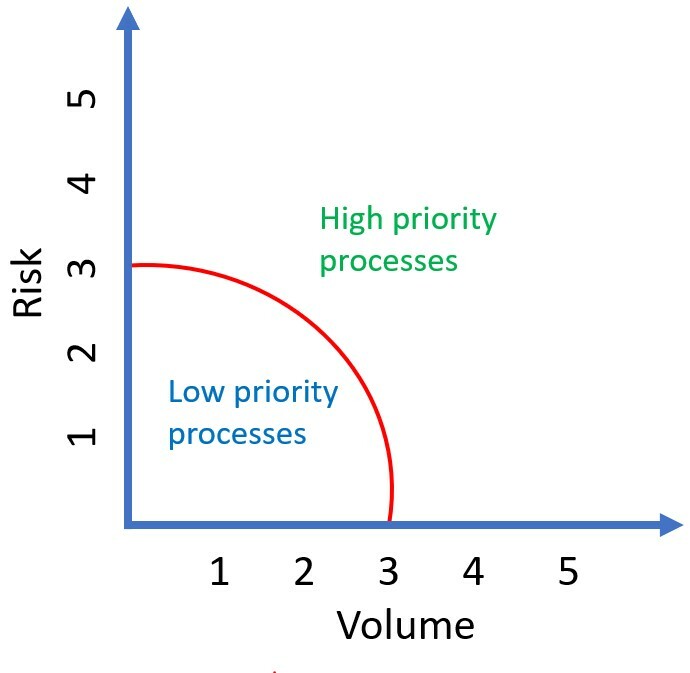
See post on SimplifyingProcesses.com
Execute your BPM plan and establish continuous improvement
As a quick recap – in Part One of this blog series, I suggested that digital transformation efforts can often be derailed by an organization’s lack of process knowledge. I followed by positioning business process management (BPM) to better understand, capture, and manage process knowledge. Then, in Part Two, I identified the three-phase approach organizations can follow to implement BPM (1. Planning – 2. Execution – 3. Continuous Improvement) and went on to exposit the Planning phase. Now, in my final post in this series, I’ll detail the key steps for successful BPM Execution and Continuous Improvement.
Execution
The Execution phase can be broken up into five subsections. First, we must have a clear understanding of the scope of the project. Second, the scope of work must be prioritized based on objective factors understandable to the stakeholders involved in the project. Thirdly, we must recruit and train participants who will assist in the implementation. Fourthly, the teams must begin documenting and publishing their business processes. And finally, once the work is complete, we must communicate the results to the organization at large and celebrate the small wins.
Let’s dive into each one of these subsections in more detail.
Scope your processes
The intent here is to bring clarity and structure to the way that your processes are organized. Typically, organizations will tend to think along departmental lines when organizing their processes. For example: human resources, finance, accounting, risk management, etc. This in and of itself is not a bad thing. However, this departmental structure should also be coupled with a cross departmental view of your processes. This is often referred to as end-to-end processes or value streams. This is where we look across different departments and define at a higher level how teams in departments work together to deliver value. Best practice includes leveraging both the departmental structure of your process classification framework as well as identifying and mapping key end-to-end processes.

Prioritize your processes
If you are planning on implementing BPM across and organization, it will be impossible to do this in one fell swoop. There are too many processes to document and too few resources to plan and execute. This means that you will need to plan on multiple phases of implementation. Once you have established a high-level process classification framework, you can then begin prioritizing the processes that should be built out in the first phase.
The temptation at this point is to simply identify the squeaky wheel. In other words, is there a certain department or group of people that are complaining about not having clear process documentation? If so, well, we should do their processes first. Although this approach is common, it does not put the needs of the organization in the forefront.
I suggest having an objective way to prioritize the order in which the processes are built. A quick and effective way to do this is to utilize a simple matrix to prioritize your processes based on factors of high risk and high volume. Removing some of the emotion from the selection process will help you clearly define the phase one scope of work based on the needs of the organization.

Recruit and train your participants
Of course, it doesn’t do much good for the effort if you have a clear scope of work and no one to build it. This is where participant identification and training come in.
When designing and documenting processes you want to seek the assistance of the subject matter experts. These are the line of business employees with the process know-how and the willingness to share. The goal here is to find one Process Owner and one Process Expert to jointly build and maintain each process in your scope of work – this two-tier ownership structure builds redundancy into how processes are managed.

Regarding the selection of these Process Owners and Experts, let me warn you here to try and avoid the STP - Otherwise known as the “same ten people.” You know who they are. They are the same people that get tapped for every initiative the company runs. If the implementation is to be successful then the subject matter experts you bring in must have the capacity to assist – the STP typically lack the capacity needed to be a part of any new implementation effort.
Additionally, when engaging line of business subject matter experts, it is important to respect the fact that they have a full-time job doing something other than supporting a BPM implementation. Try to be as clear and objective as possible with outlining the expectations of their involvement. That means giving them a scope of work and estimated number of hours required to fulfill it. They need to know what they are committing to if it is going to be a reliable commitment.
If you are fortunate enough to recruit the right subject matter experts to assist in the implementation effort, you then must equip and train them to be successful. This includes training on how to design and document process information as well as technical training specific to your digital process platform. It is also helpful to think through the logistical requirements for training the participants. This includes such things as where the training is held – remotely or on-site, the total duration of the training, and number of participants for each phase.
Build and publish your processes
After training is complete you now must challenge the Process Owners and Experts to begin building out their processes as quickly as possible. As these individuals go back to their day jobs, the temptation is to put off implementing any of the process writing skills they learned during the training until they feel totally caught up with their normal responsibilities.
One way to encourage the training participants to get started quickly is challenging them to schedule a four-hour chunk of time within the first seven days after completing the training. During this chunk of time they will work with their Process Owner or Expert partner to begin sketching out and building their process. This allows them to utilize the skills gained during the training before those skills fade.
Once the teams get started, it is helpful to check in on a regular basis to review process quality and progress. Having a progress checklist where you evaluate and categorize each of the processes being built can aid with this. When teams get behind schedule, reach out immediately to diagnose why they are struggling. This may mean that you need to help or, even in some cases, replace the Process Owner or Expert teams with other individuals to ensure completion within the committed timeframe. Finally, as the teams reach completion, set up process publish calls where you as the implementation leader can do a final review of process quality with those individuals before the process is published and made available for others in the organization to use.
Communicate and celebrate the results
Now that the first version of your processes is complete and published it is now time to communicate those results to the rest of the organization. This is where you want to tap into those communication channels previously established with your executive sponsors. Oftentimes, it is best to script the communications that are to go out to the organization and simply leverage the executive team as the mouthpiece. If there are time or cost savings associated with the new process standards be sure to include those in the communications.
Also look at those mid-level and grass-roots level communication channels. Perhaps middle management can mention the implementation effort and issue a call to action in a departmental staff meeting. Front-line advocates can oftentimes generate a ton of interest by supporting BPM in any peer groups they may be a part of. The point here is to exhaust all your communication channels. Do not simply rely on the company newsletter to get the word out or assume that word will spread automatically through the organization.
Lastly, encourage the executive sponsors to also publicly thank the Process Owners and Experts for their time and efforts given to the BPM implementation. This can be something as simple as a post on the company Slack channel or a shout-out in the next company staff meeting. It is amazing what a little bit of public recognition for a job well done will do. Oftentimes, this generates interest from other line-of-business experts regarding business process management – potentially opening the door to recruiting Process Owners and Experts for future phases of implementation.
Continuous Improvement
In BPM implementations, the most difficult part of the effort is maintaining current and up-to-date process information after the initial documentation is complete. To support this, processes must enter the improvement cycle. The concept behind this is quite simple, once processes are captured and published, they should always be progressing towards the next, better and improved version.
This progression is going to be driven in large part by end-user feedback. Once the target audience begins consuming process content, they will see ways in which the current standard can be improved. It is important that there is a channel for those users to deliver their feedback and a mechanism in place to respond to that feedback. It is at this point where the Process Owner and Process Expert model is so helpful. When Owners and Experts become accountable for receiving and replying to process feedback, maintaining up-to-date standard processes becomes part of the organizational culture.

However, it is prudent to plan for the replacement of the original Process Owners and Process Experts. As individuals serve in these rolls for extended periods of time, perhaps due to capacity issues or changing responsibilities within the organization, it makes sense for those individuals to cycle out and bring in new employees to backfill the Owner and Expert responsibilities. Something to consider here is asking the outgoing Owner and Expert to recruit their replacements. Since those individuals are tied into the line of business, they have a better understanding of the skill set and capacity of their peers and can select a great replacement for the specific process or processes that they are currently overseeing.
Finally, don’t expect that the structure and content of your processes will remain the same year after year. As your process content matures there will be natural process gaps and overlaps that become apparent. Existing processes may need to be merged together to create a larger process or redundant processes that overlap may need to be removed in order to create clarity. Always be open to critical evaluation of the process structure.
Conclusion
In an effort not to reinvent the wheel, I’ll simply paraphrase from my first post in this series:
Allowing technological advancements to drive our transformation efforts is not good enough. Just because we can implement a certain technology does not mean we should! BPM helps us answer not only the question “should we?” but also “where, how and when?”.
Many organizations forego this critical component because, quite frankly, doing BPM correctly is hard work. But, hard work or not, we must recover BPM if we are to create a work culture where processes are properly designed, clearly understood, and intentionally analyzed for improvement opportunities. When this takes place, we ensure the investment in supporting technologies is made purposefully and responsibly, opening the door for successful digital transformation.


